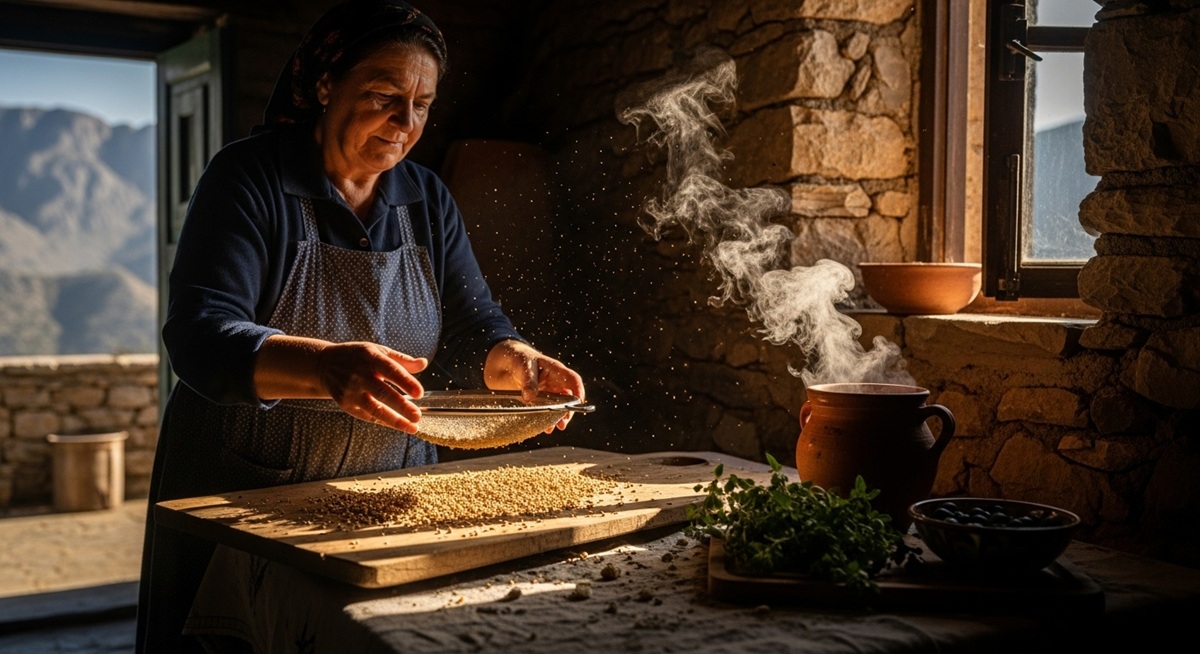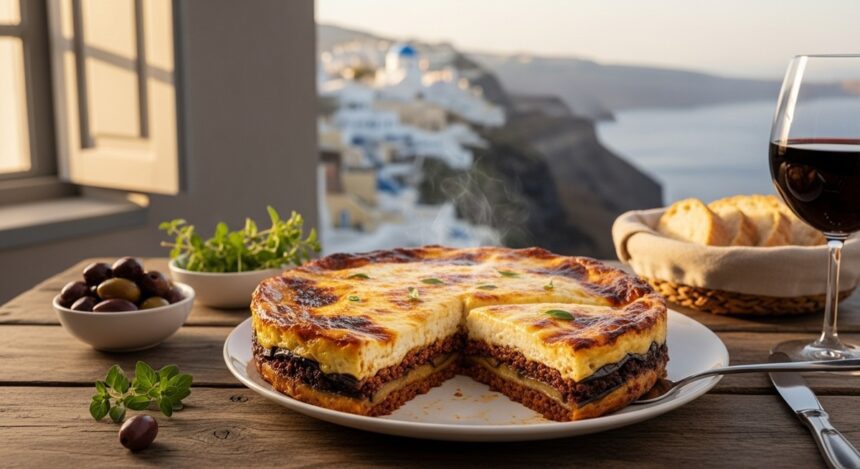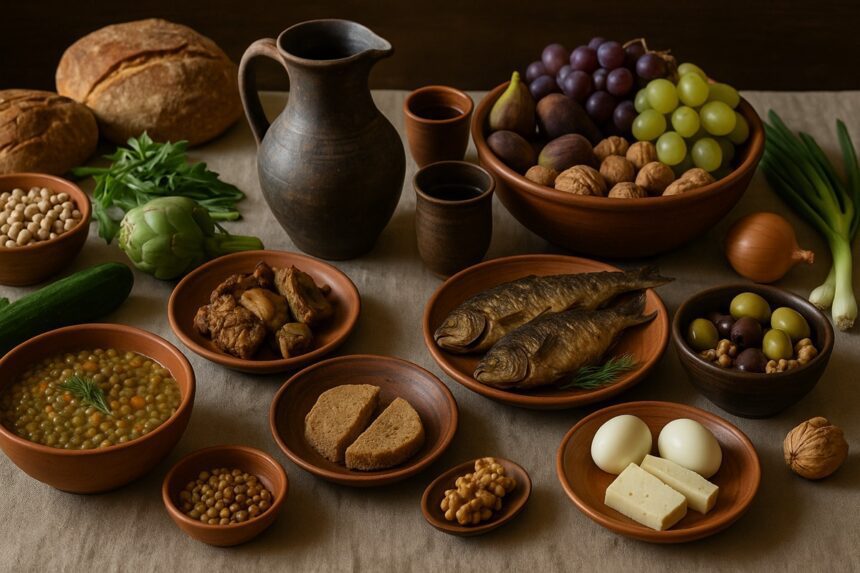“There is no wealth but life.” — John Ruskin (A reflection on the true value of simple, enduring sustenance)
The vibrant pulse of modern Greece beats to the essential rhythm of its deep, ancient past. While visitors flock to the dazzling island beaches and iconic temples, the country’s most profound soul lies tucked away in its rugged mountains and the deeply rooted traditions of the hearth. Nothing embodies this enduring spirit quite like Trahanas—a humble, sun-dried wheat and yogurt product that is far more than a simple grain—it is an authentic culinary time capsule.
The Golden Grain: A History Woven into the Greek Landscape
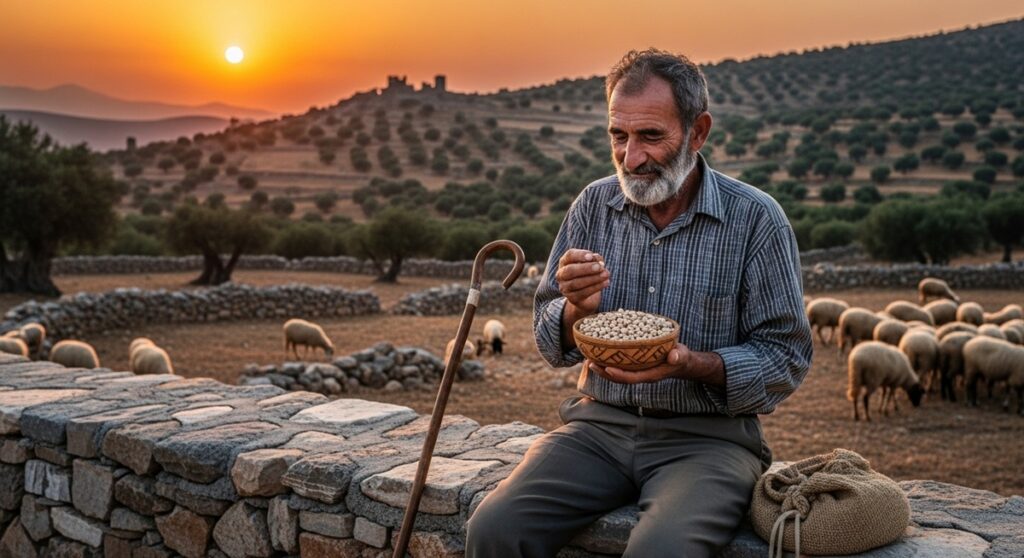
To truly understand Trahanas is to understand the demanding, unique geography and the cyclical history of Greece. It is a food of essential preservation, born of practical necessity and elevated by centuries of unwavering tradition.
The Pastoral Legacy and the Preservation of Plenty
Trahanas is fundamentally a preserved, fermented product, a mixture of flour (or sometimes cracked wheat) and dairy (usually goat’s milk or yogurt) kneaded into a coarse dough. This dough is meticulously dried in the intense late summer sun, and then broken into small, pebble-like grains. This efficient, ingenious process was the ancient world’s resourceful answer to modern refrigeration.
The dish’s Ancient Roots are undeniable; though the name is likely derived from the Byzantine era (tragana or traksana), the core technique of preserving grain with fermented milk stretches back to Ancient Greek and Roman times. It represents the ancient, critical ritual of storing the harvest for winter, a foundational task watched over by the gods of agriculture. It was the quintessential Shepherd’s Sustenance: lightweight, non-perishable, and quickly transforms into a hearty, warming meal. Its simple variations (sweet or sour) authentically reflect the local ingredients available to Greek villagers and shepherds across diverse regions.
From Byzantine Tables to the Modern Village Kitchen
During the powerful Byzantine Empire, Trahanas was a known and highly valued commodity, often mentioned in official texts as a vital staple food for both the imperial army and the common people. Its ability to last and travel made it indispensable across the wide territory. Today, it remains the ultimate Greek comfort food, symbolizing the resourceful simplicity and deep continuity of rural life. When the first sharp autumn chill descends upon the mountains, the evocative, comforting scent of Trahanas simmering on a stovetop signals that the Sacred Hearth—the heart of the family kitchen—is ready to anchor the household for the coming winter.
Where History and Recipe Intersect: Trahanas and Greek Mythology

The annual, timely preparation of Trahanas in late summer and its vital consumption in autumn perfectly mirrors a central, powerful myth in the Greek pantheon: the cycle of death, preservation, and essential rebirth.
Demeter and the Grain of Life
The yearly life-cycle of the dish aligns perfectly with the famous myth of Demeter and Persephone. The Harvest (Summer) sees Trahanas created and preserved when Demeter (Goddess of the Harvest) is happiest and the sun is strongest, embodying the peak of life and abundance. The Descent (Autumn/Winter) begins as Persephone descends to the Underworld and Demeter grieves, causing the earth to become dormant and cold. Trahanas, stored and ready, represents the preserved seed or life force that sustains humanity through the cold months, powerfully promising renewal when spring eventually returns. It is the earthy, reliable comfort granted to mortals during the gods’ turbulent seasonal drama.
The Wild Greens of the Land (Choˊrta)
The essential addition of wild greens (Choˊrta) to the soup further grounds the dish in the resilient Greek landscape. Gathering choˊrta is an ancient, therapeutic tradition, connecting the forager directly to the land’s primal bounty—the same earth that sustained the heroes and mortals of Greek myth. It’s a purposeful act of recognizing the raw, enduring power of nature, irrespective of the passing seasons, and provides a necessary bitterness to balance the grain.
The Sacred Hearth: Trahanas Soup with Wild Greens Recipe
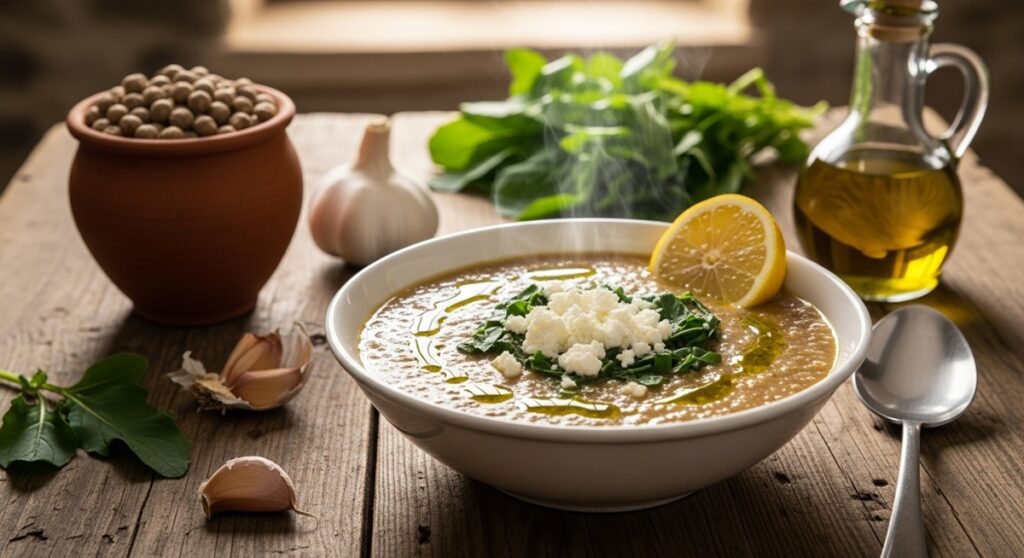
This recipe transforms simple ingredients into the quintessential Greek comfort food. It is a testament to the essential resourcefulness of the Greek villagers and the enduring power of the harvest.
The Trahanas Recipe: A Simple Ritual
This version focuses on the savory (sour) Trahanas (ksinótrahanas), which is most popular in the mountains, balanced perfectly with fresh greens and finished with bright olive oil.
Ingredients (Serves 4)
- For the Soup Base: 1 cup Trahanas (preferably sour/ksinótrahanas); 4-5 cups Vegetable or Chicken stock (or water); 1 tbsp Extra Virgin Greek Olive Oil (plus more for serving); 1 small onion, finely chopped; 1 large clove garlic, minced.
- For the Wild Greens (Choˊrta): 2 cups mixed wild greens (e.g., spinach, kale, Swiss chard, or actual foraged choˊrta), roughly chopped.
- Seasoning & Finish: Salt and freshly ground black pepper to taste; Juice of half a lemon (optional, but highly recommended); Crumbled Feta cheese for garnish (optional).
Instructions: Preparing the Pastoral Comfort
- Sauté the Aromatics: In a medium-sized, heavy-bottomed pot, heat 1 tablespoon of olive oil over medium heat. Add the chopped onion and sauté for about 5 minutes until soft and translucent. Add the minced garlic and cook for 1 minute more until fragrant.
- Toast the Trahanas: Add the 1 cup of Trahanas to the pot. Stir continuously for 2-3 minutes, lightly toasting the grain. This subtle, important step enhances the final soup’s nutty, complex flavor.
- Simmer and Hydrate: Pour in the 4-5 cups of stock (or water). Bring the liquid to a boil, then immediately reduce the heat to low. Stir well to prevent sticking. Cover the pot and let it simmer gently for 15-20 minutes, or until the grain is tender and the liquid has thickened.
- Expert Tip: The consistency of the final soup is a key preference. For a thick, satisfying porridge-like consistency (more comforting in deep winter), use the lesser amount of liquid or simmer longer. For a thinner, soupy broth, add a little more hot stock as it cooks.
- Add the Greens: During the last 5 minutes of simmering, stir in the wild greens (choˊrta). Stir well until they wilt and integrate completely into the soup.
- Season and Serve: Remove the pot from the heat. Stir in salt, pepper, and the fresh lemon juice (if using). Ladle the piping hot soup into deep bowls. Finish with a generous drizzle of high-quality Greek olive oil and a final sprinkle of crumbled Feta cheese for a rich, tangy flourish.
Enjoy a dish that has nourished Greek people from the Byzantine era to today, directly connecting you to the enduring resilience and vital history of the land.
A Culinary Pilgrimage: Trahanas and Greek Travel
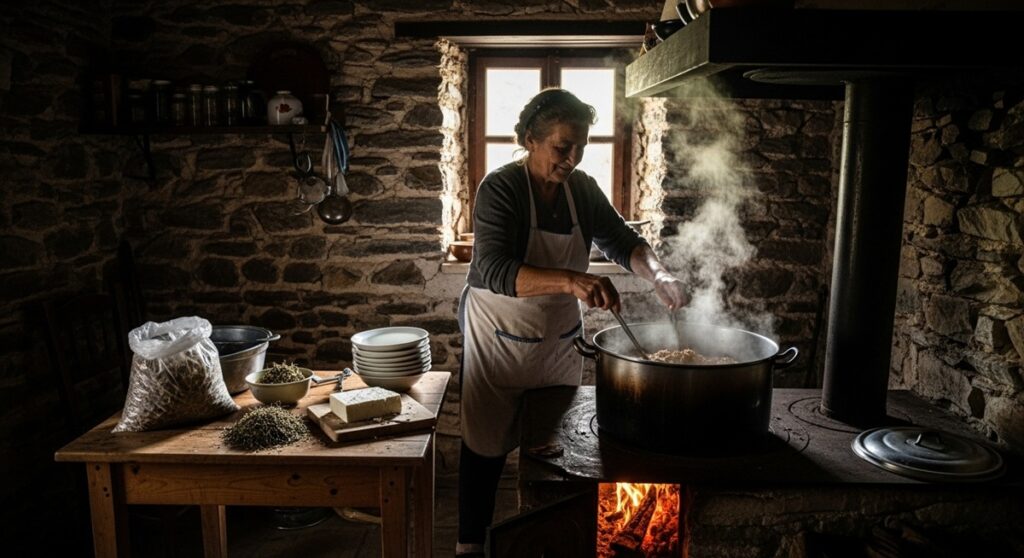
For the discerning traveler, actively seeking out and consuming Trahanas offers a rich, deep dive into authentic Greek culture that large, bustling tourism destinations often miss.
The Best Regions for the Trahanas Experience
To truly appreciate this deeply personal dish is to visit the places where the pastoral comfort remains an unbroken way of life.
- Epirus and Thessaly (The Mainland): These rugged, vast mountainous regions are the indisputable heartland of Trahanas. Travelers visiting the breathtaking Zagori villages or the awe-inspiring monasteries of Meteora will find Trahanas on every traditional tavern menu. Here, you truly taste the cold, clean mountain air and the wood-smoke in every single spoonful.
- Arcadia (The Peloponnese): The ancient, pastoral home of the god Pan remains a place of shepherds and timeless traditions. Exploring the traditional stone villages and gorges of Arcadia means discovering family-made, truly authentic Trahanas often flavored simply with feta and freshly gathered mountain herbs. It’s a literal walk into the pastoral idyll of Greek literature.
Integrating the Recipe into Your Greek Vacation
Trahanas is not merely a meal; it’s an ideal opportunity for rich experiential travel. Look for:
- Village Festivals: In early autumn, many secluded villages hold small, spirited festivals celebrating the final harvest and the necessary preparation of winter goods, often featuring fresh, communally made Trahanas.
- Boutique Stays: Opt for traditional guesthouses (archontika) that proudly serve homemade breakfast. It’s here, often next to a crackling fireplace, that you’ll find the purest, most comforting bowl of Trahanas.
- The Authentic Souvenir: Forget the kitschy fridge magnets. A bag of locally made, sun-dried Trahanas is the ultimate authentic Greek souvenir, carrying the complex flavor of the mountains and the enduring spirit of the Byzantine age back to your own kitchen.
In a world increasingly seeking faster, easier food, Trahanas stands as a powerful testament to the value of patience, unbroken tradition, and the enduring connection between the Greek people and the resilient earth beneath their feet. It is the sacred dish that transforms the humble harvest into a comforting, soul-warming anchor for the autumn and winter months.







